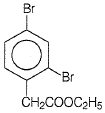3-Hexyne can be converted to trans-3-Hexene by the action of:
1. - Pd/
2. Li-Liq.
3. - Pt
4.

To unlock all the explanations of this course, you need to be enrolled.

To unlock all the explanations of this course, you need to be enrolled.
The most suitable reagent among the following that is used to distinguish compound (III) from the rest of the compounds is -
I.
II.
III.
IV.
| 1. | Br2/CCl4 | 2. | Br2/CH3COOH |
| 3. | Alk.KMnO4 | 4. | Ammoniacal AgNO3 |

To unlock all the explanations of this course, you need to be enrolled.

To unlock all the explanations of this course, you need to be enrolled.
The reaction,
+ + HCl
is an example of:
1. Friedel-Crafts reaction
2. Kolbe's synthesis
3. Wurtz's reaction
4. Grignard synthesis

To unlock all the explanations of this course, you need to be enrolled.

To unlock all the explanations of this course, you need to be enrolled.
RCOCl and are used in the Friedel-Crafts reaction.
The electrophile among the following is:
1.
2. RCOCl
3. O
4.

To unlock all the explanations of this course, you need to be enrolled.

To unlock all the explanations of this course, you need to be enrolled.
The D in the above-mentioned reaction is -
| 1. |  |
2. |  |
| 3. |  |
4. |  |

To unlock all the explanations of this course, you need to be enrolled.

To unlock all the explanations of this course, you need to be enrolled.
A compound that gives an optically inactive compound on treatment with H2(2 moles)/ Pt is-
1. 3-Methyl-1-pentyne
2. 4-Methyl-1-hexyne
3. 3-Methyl-1-heptyne
4. None of the above

To unlock all the explanations of this course, you need to be enrolled.

To unlock all the explanations of this course, you need to be enrolled.

The final product in the above sequence of reactions is-
| 1. |  |
| 2. |  |
| 3. |  |
| 4. |  |

To unlock all the explanations of this course, you need to be enrolled.

To unlock all the explanations of this course, you need to be enrolled.
Product (B) in the above mentioned reaction is-
| 1. |  |
2. |  |
| 3. |  |
4. |  |

To unlock all the explanations of this course, you need to be enrolled.

To unlock all the explanations of this course, you need to be enrolled.
A non-aromatic compound among the following compounds is:
| 1. |  |
2. |  |
| 3. |  |
4. |  |

To unlock all the explanations of this course, you need to be enrolled.

To unlock all the explanations of this course, you need to be enrolled.
A compound among the following that gives the maximum % of meta product on nitration
(using HNO3/H2SO4) is :
1. Toluene
2. Aniline
3. Benzene
4. Isopropyl benzene

To unlock all the explanations of this course, you need to be enrolled.

To unlock all the explanations of this course, you need to be enrolled.




